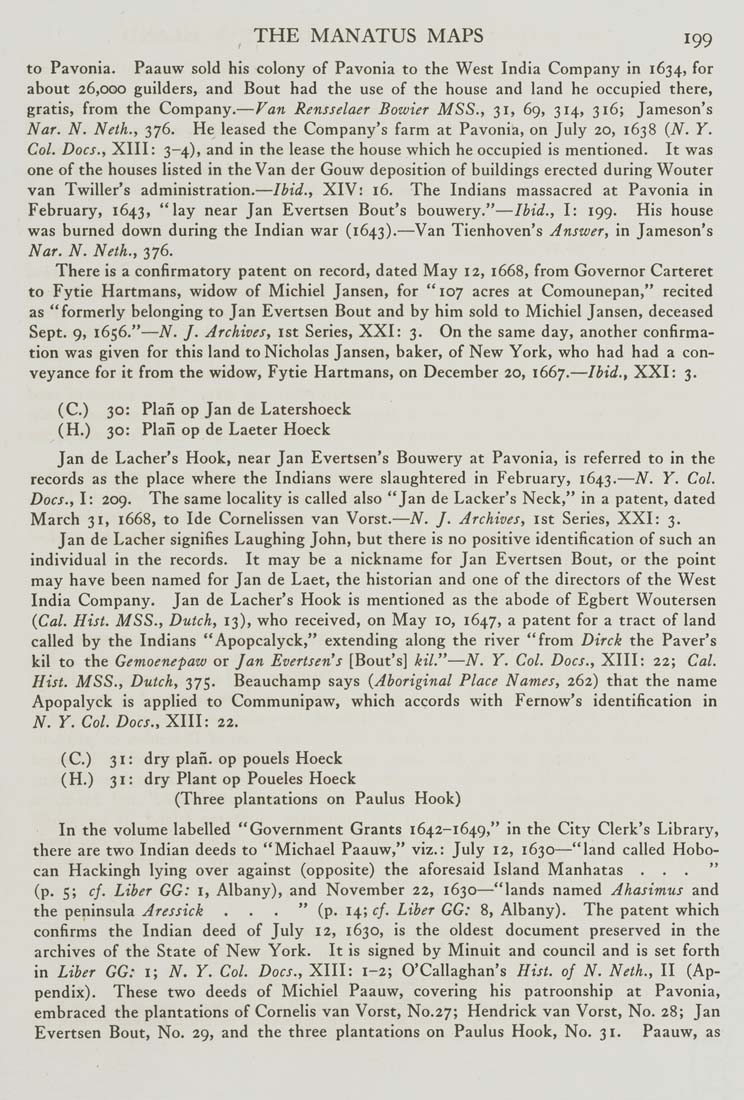THE MANATUS MAPS 199
to Pavonia. Paauw sold his colony of Pavonia to the West India Company in 1634, for
about 26,000 guilders, and Bout had the use of the house and land he occupied there,
gratis, from the Company.—Van Rensselaer Bowier MSS., 31, 69, 314, 316; Jameson's
Nar. N. Neth., 376. He leased the Company's farm at Pavonia, on July 20, 1638 {N. Y.
Col. Docs., XIII: 3-4), and in the lease the house which he occupied is mentioned. It was
one of the houses listed in the Van der Gouw deposition of buildings erected during Wouter
van Twiller's administration.—Ibid., XIV: 16. The Indians massacred at Pavonia in
February, 1643, "lay near Jan Evertsen Bout's bouwery."—Ibid., I: 199. His house
was burned down during the Indian war (1643).—Van Tienhoven's Answer, in Jameson's
Nar. N. Neth., 376.
There is a confirmatory patent on record, dated May 12, 1668, from Governor Carteret
to Fytie Hartmans, widow of Michiel Jansen, for "107 acres at Comounepan," recited
as "formerly belonging to Jan Evertsen Bout and by him sold to Michiel Jansen, deceased
Sept. 9, 1656."—A'^. /. Archives, 1st Series, XXI: 3. On the same day, another confirma¬
tion was given for this land to Nicholas Jansen, baker, of New York, who had had a con¬
veyance for it from the widow, Fytie Hartmans, on December 20, 1667.—Ibid., XXI: 3.
(C.) 30: Plaii op Jan de Latershoeck
(H.) 30: Plaii op de Laeter Hoeck
Jan de Lacher's Hook, near Jan Evertsen's Bouwery at Pavonia, is referred to in the
records as the place where the Indians were slaughtered in February, 1643.—A^. Y. Col.
Docs., I: 209. The same locality is called also "Jan de Lacker's Neck," in a patent, dated
March 31, 1668, to Ide Cornelissen van Vorst.—N. f. Archives, ist Series, XXI: 3.
Jan de Lacher signifies Laughing John, but there is no positive identification of such an
individual in the records. It may be a nickname for Jan Evertsen Bout, or the point
may have been named for Jan de Laet, the historian and one of the directors of the West
India Company. Jan de Lacher's Hook is mentioned as the abode of Egbert Woutersen
{Cal. Hist. MSS., Dutch, 13), who received, on May 10, 1647, a patent for a tract of land
called by the Indians "Apopcalyck," extending along the river "from Dirck the Paver's
kil to the Gemoenepaw or fan Evertsen's [Bout's] kil."—N. Y. Col. Docs., XIII; 22; Cal.
Hist. MSS., Dutch, 375. Beauchamp says {Aboriginal Place Names, 262) that the name
Apopalyck is applied to Communipaw, which accords with Fernow's identification in
A^. Y. Col. Docs., Xlll: 22.
(C.) 31: dry plaii. op pouels Hoeck
(H.) 31: dry Plant op Poueles Hoeck
(Three plantations on Paulus Hook)
In the volume labelled "Government Grants 1642-1649," in the City Clerk's Library,
there are two Indian deeds to "Michael Paauw," viz.: July 12, 1630—"land called Hobo-
can Hackingh lying over against (opposite) the aforesaid Island Manhatas ..."
(p. 5; cf. Liber GG: 1, Albany), and November 22, 1630—"lands named Ahasimus and
the peninsula Aressick ..." (p. 14; cf. Liber GG: 8, Albany). The patent which
confirms the Indian deed of July 12, 1630, is the oldest document preserved in the
archives of the State of New York. It is signed by Minuit and council and is set forth
in Liber GG: 1; N.Y. Col. Docs., XIII: 1-2; O'Callaghan's Hist, of N. Neth., II (Ap¬
pendix). These two deeds of Michiel Paauw, covering his patroonship at Pavonia,
embraced the plantations of Cornelis van Vorst, No.27; Hendrick van Vorst, No. 28; Jan
Evertsen Bout, No. 29, and the three plantations on Paulus Hook, No. 31. Paauw, as
|








